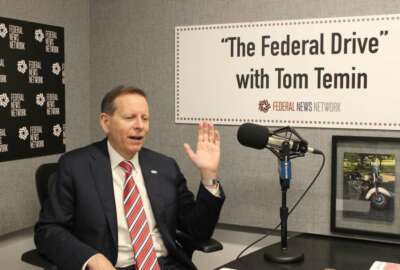Certain veterans can now sign up for disability from burn pit exposure
The Veterans Benefits Administration is about to start paying disability benefits for those exposed to fumes from burn pits in the Middle East as far back as the...
Best listening experience is on Chrome, Firefox or Safari. Subscribe to Federal Drive’s daily audio interviews on Apple Podcasts or PodcastOne.
The Veterans Benefits Administration is about to start paying disability benefits for those exposed to fumes from burn pits in the Middle East as far back as the Gulf War. Payments will go to those with asthma, rhinitis or sinusitis. The new benefit comes after years of complaints and lobbying Congress. For what it means to VBA, Federal Drive with Tom Temin spoke with the Executive Director of Compensation Service, Beth Murphy.
Interview transcript:
Tom Temin: And just as a basic measure, do we know how many veterans are potentially affected here in the first place?
Beth Murphy: Well, Tom, up to three and a half million veterans could be impacted by this, those that were deployed to the Southwest Asia theater, or in locations such as Afghanistan, Pakistan, Syria, Djibouti.
Tom Temin: Right, so three and a half million. And do you have any metrics on how many people have been applying for this benefit but had been denied, because it wasn’t statutorily required until now?
Beth Murphy: Well, we did have some that were denied. We’ve sent outreach letters to those folks encouraging them to reapply. I can tell you that already we have processed about 4000 claims and granted millions of dollars in benefits to these veterans. So we’re working them and processing them and paying claims.
Tom Temin: So of the 3.5 million potential, that’s not how many are known to be sick, that’s just the population of people that served in those areas during those designated years.
Beth Murphy: Yes, that’s correct, Tom.
Tom Temin: Now define for us presumptive benefit. I think that was the same that was used for the Blue Water Gulf veterans from Vietnam era where the ships carried the napalm in canisters, there was a presumptive benefit there. What does that mean, and how does that apply here?
Beth Murphy: So presumptive service connection makes it easier for a veteran to become entitled for certain designated conditions. Tom, you’re correct. We extended a couple of years ago additional Agent Orange related conditions for Blue Water Navy veterans. We’ve added fairly recently based on some congressional action, three additional presumptives for Vietnam veterans who were deployed due to Agent Orange. But in this case, what we’re doing most recently is adding presumptive conditions for Gulf War veterans who were deployed. There are three elements to establish service connection. First, you have to have a chronic condition. It has to be due to an incident or an illness or an injury in service. And then there must be a link, a causal connection. What the presumptive part of this does is we presume that there is a link, so it makes it easier for a veteran to establish entitlement to those benefits.
Tom Temin: And you have carefully defined what those ailments might be that would get there — asthma, rhinitis, I believe it is, and sinusitis. Correct?
Beth Murphy: That’s correct. All three are respiratory conditions. So if you have a chronic respiratory condition, even if you’re not sure what the diagnosis is, we’re encouraging you to come to us file a claim, look for information, and we’re here to help.
Tom Temin: And are the adjudicators mostly still working remotely, and how does it day to day there for VBA in just the normal processing of benefits claims?
Beth Murphy: Well, we have been able through technology and digitizing many of our records over the past several years. It’s really put us in a great position to be nimble and flexible and to not miss a beat. And the claims processors have been teleworking during the pandemic. And we’ve completed some of the highest numbers of claims annually in the last couple of years than we ever have. So it’s working quite well, and continuing to serve veterans despite any roadblocks.
Tom Temin: Yes, because VBA had some serious backlogs, which I think were largely worked down to where the backlog pool is what you would expect to be in order to grant benefits in the required time limit. I think it’s 90 days if I’m correct. Do you expect this benefit to create a new workload such that you could get into a backlog situation again?
Beth Murphy: Well Tom, we define a case that’s in backlog is any case pending more than 125 days. And the number of inventory overall has been growing as we’ve added new presumptive conditions. The backlog has crept up a bit because as these cases are put kind of in bulk into our inventory so that we can work them, and then they aged into 125 days, then we see these kind of short term spikes in our backlog. But we’re working them down, we’e proactively hiring additional staff, getting them trained up. And as I said, our flexibility to be able to telework during this last couple of years has really been a big lift for us.
Tom Temin: And is there any kind of technical support, especially the might work efficiently in a presumptive situation, because the basic facts of presumption can be established easily. There are digital records for all of this. And then the only thing you need to add is some assertion, say by a doctor, that yes, this person has asthma.
Beth Murphy: Yes, I have to say, digitizing our records over the last many years has been a huge positive impact for us. If there are treatment records available in VHA or through a private provider, we can very quickly retrieve those for the veteran. And if necessary, we can schedule a VA examination. And that would be at no cost to the veteran just to assess and validate the severity of the condition. So there is a lot of support, a lot of assistance for veterans to go through this process.
Tom Temin: And is there an estimate of what the burn pit benefits will cost per year, and did Congress help out with that?
Beth Murphy: Well, there have been estimates, there have been projections, those have been shared. And right now we’re really focused on assisting veterans to get these benefits that have been granted. And it’s the right thing to do.
Tom Temin: Sure. And you mentioned you have processed 4,000. How many are sitting there in the hopper?
Beth Murphy: I would have to check. It’s I think we’ve got maybe two or three times that many that are still in process. But like I said, it is a process to gather the information, private VHA records, get exams scheduled and conducted. But we’re working through them, paying claims, and making sure veterans are receiving what they’re entitled to.
Tom Temin: Sure, and you’re doing a major national outreach too to make sure that everyone knows.
Beth Murphy: Absolutely, we’re on social media. I’m reaching out through various outlets. And we have sent outreach letters to those who were previously denied to encourage them to reapply.
Tom Temin: Alright, Beth Murphy is executive director of compensation services at the Veterans Benefits Administration. Thanks so much.
Beth Murphy: Thanks for having me on your program Tom.
Copyright © 2024 Federal News Network. All rights reserved. This website is not intended for users located within the European Economic Area.
Tom Temin is host of the Federal Drive and has been providing insight on federal technology and management issues for more than 30 years.
Follow @tteminWFED






